+ Open data
Open data
- Basic information
Basic information
| Entry | Database: PDB / ID: 7lde | ||||||
|---|---|---|---|---|---|---|---|
| Title | native AMPA receptor | ||||||
 Components Components |
| ||||||
 Keywords Keywords |  MEMBRANE PROTEIN / MEMBRANE PROTEIN /  neurotransmitter / hippocampus / neurotransmitter / hippocampus /  ion-channel / ion-channel /  glycosylation glycosylation | ||||||
| Function / homology |  Function and homology information Function and homology informationPhase 2 - plateau phase / Activation of AMPA receptors / Phase 0 - rapid depolarisation / negative regulation of receptor localization to synapse / negative regulation of anterograde synaptic vesicle transport / Synaptic adhesion-like molecules / Cargo concentration in the ER / Unblocking of NMDA receptors, glutamate binding and activation / LGI-ADAM interactions / COPII-mediated vesicle transport ...Phase 2 - plateau phase / Activation of AMPA receptors / Phase 0 - rapid depolarisation / negative regulation of receptor localization to synapse / negative regulation of anterograde synaptic vesicle transport / Synaptic adhesion-like molecules / Cargo concentration in the ER / Unblocking of NMDA receptors, glutamate binding and activation / LGI-ADAM interactions / COPII-mediated vesicle transport / Trafficking of AMPA receptors / cellular response to amine stimulus / axonal spine / Trafficking of GluR2-containing AMPA receptors / positive regulation of membrane potential / localization within membrane / cellular response to ammonium ion / neurotransmitter receptor transport, postsynaptic endosome to lysosome /  L-type voltage-gated calcium channel complex / neurotransmitter receptor activity involved in regulation of postsynaptic cytosolic calcium ion concentration / L-type voltage-gated calcium channel complex / neurotransmitter receptor activity involved in regulation of postsynaptic cytosolic calcium ion concentration /  myosin V binding / neuron spine / myosin V binding / neuron spine /  regulation of AMPA receptor activity / neurotransmitter receptor internalization / channel regulator activity / protein phosphatase 2B binding / response to arsenic-containing substance / cellular response to dsRNA / dendritic spine membrane / postsynaptic neurotransmitter receptor diffusion trapping / anchoring junction / glutamate-gated calcium ion channel activity / long-term synaptic depression / cellular response to peptide hormone stimulus / regulation of AMPA receptor activity / neurotransmitter receptor internalization / channel regulator activity / protein phosphatase 2B binding / response to arsenic-containing substance / cellular response to dsRNA / dendritic spine membrane / postsynaptic neurotransmitter receptor diffusion trapping / anchoring junction / glutamate-gated calcium ion channel activity / long-term synaptic depression / cellular response to peptide hormone stimulus /  beta-2 adrenergic receptor binding / beta-2 adrenergic receptor binding /  protein kinase A binding / neuronal cell body membrane / spinal cord development / perisynaptic space / transmission of nerve impulse / AMPA glutamate receptor activity / COPII-coated ER to Golgi transport vesicle / regulation of postsynaptic membrane neurotransmitter receptor levels / response to lithium ion / protein kinase A binding / neuronal cell body membrane / spinal cord development / perisynaptic space / transmission of nerve impulse / AMPA glutamate receptor activity / COPII-coated ER to Golgi transport vesicle / regulation of postsynaptic membrane neurotransmitter receptor levels / response to lithium ion /  immunoglobulin binding / AMPA glutamate receptor complex / immunoglobulin binding / AMPA glutamate receptor complex /  adenylate cyclase binding / adenylate cyclase binding /  excitatory synapse / excitatory synapse /  ionotropic glutamate receptor complex / calcium channel regulator activity / asymmetric synapse / G-protein alpha-subunit binding / regulation of receptor recycling / neuronal action potential / ionotropic glutamate receptor complex / calcium channel regulator activity / asymmetric synapse / G-protein alpha-subunit binding / regulation of receptor recycling / neuronal action potential /  voltage-gated calcium channel activity / regulation of postsynaptic membrane potential / voltage-gated calcium channel activity / regulation of postsynaptic membrane potential /  glutamate receptor binding / glutamate receptor binding /  postsynaptic density, intracellular component / positive regulation of synaptic transmission / endoplasmic reticulum to Golgi vesicle-mediated transport / postsynaptic density, intracellular component / positive regulation of synaptic transmission / endoplasmic reticulum to Golgi vesicle-mediated transport /  long-term memory / response to electrical stimulus / presynaptic active zone membrane / glutamate-gated receptor activity / response to fungicide / somatodendritic compartment / cellular response to brain-derived neurotrophic factor stimulus / long-term memory / response to electrical stimulus / presynaptic active zone membrane / glutamate-gated receptor activity / response to fungicide / somatodendritic compartment / cellular response to brain-derived neurotrophic factor stimulus /  synapse assembly / dendrite membrane / ligand-gated monoatomic ion channel activity involved in regulation of presynaptic membrane potential / synapse assembly / dendrite membrane / ligand-gated monoatomic ion channel activity involved in regulation of presynaptic membrane potential /  ionotropic glutamate receptor binding / positive regulation of synaptic transmission, glutamatergic / response to cocaine / dendritic shaft / ionotropic glutamate receptor binding / positive regulation of synaptic transmission, glutamatergic / response to cocaine / dendritic shaft /  synaptic membrane / synaptic membrane /  synaptic transmission, glutamatergic / synaptic transmission, glutamatergic /  regulation of membrane potential / transmitter-gated monoatomic ion channel activity involved in regulation of postsynaptic membrane potential / regulation of membrane potential / transmitter-gated monoatomic ion channel activity involved in regulation of postsynaptic membrane potential /  PDZ domain binding / long-term synaptic potentiation / cellular response to amino acid stimulus / postsynaptic density membrane / Schaffer collateral - CA1 synapse / PDZ domain binding / long-term synaptic potentiation / cellular response to amino acid stimulus / postsynaptic density membrane / Schaffer collateral - CA1 synapse /  regulation of synaptic plasticity / modulation of chemical synaptic transmission / regulation of synaptic plasticity / modulation of chemical synaptic transmission /  neuromuscular junction / neuromuscular junction /  receptor internalization / response to toxic substance / cerebral cortex development / synaptic vesicle membrane / receptor internalization / response to toxic substance / cerebral cortex development / synaptic vesicle membrane /  small GTPase binding / recycling endosome membrane / G-protein beta-subunit binding / cell-cell junction / small GTPase binding / recycling endosome membrane / G-protein beta-subunit binding / cell-cell junction /  synaptic vesicle / presynapse / response to estradiol / synaptic vesicle / presynapse / response to estradiol /  presynaptic membrane / presynaptic membrane /  amyloid-beta binding / amyloid-beta binding /  cell body cell bodySimilarity search - Function | ||||||
| Biological species |   Mus musculus (house mouse) Mus musculus (house mouse) | ||||||
| Method |  ELECTRON MICROSCOPY / ELECTRON MICROSCOPY /  single particle reconstruction / single particle reconstruction /  cryo EM / Resolution: 3.9 Å cryo EM / Resolution: 3.9 Å | ||||||
 Authors Authors | Yu, J. / Rao, P. / Gouaux, E. | ||||||
| Funding support |  United States, 1items United States, 1items
| ||||||
 Citation Citation |  Journal: Nature / Year: 2021 Journal: Nature / Year: 2021Title: Hippocampal AMPA receptor assemblies and mechanism of allosteric inhibition. Authors: Jie Yu / Prashant Rao / Sarah Clark / Jaba Mitra / Taekjip Ha / Eric Gouaux /  Abstract: AMPA-selective glutamate receptors mediate the transduction of signals between the neuronal circuits of the hippocampus. The trafficking, localization, kinetics and pharmacology of AMPA receptors are ...AMPA-selective glutamate receptors mediate the transduction of signals between the neuronal circuits of the hippocampus. The trafficking, localization, kinetics and pharmacology of AMPA receptors are tuned by an ensemble of auxiliary protein subunits, which are integral membrane proteins that associate with the receptor to yield bona fide receptor signalling complexes. Thus far, extensive studies of recombinant AMPA receptor-auxiliary subunit complexes using engineered protein constructs have not been able to faithfully elucidate the molecular architecture of hippocampal AMPA receptor complexes. Here we obtain mouse hippocampal, calcium-impermeable AMPA receptor complexes using immunoaffinity purification and use single-molecule fluorescence and cryo-electron microscopy experiments to elucidate three major AMPA receptor-auxiliary subunit complexes. The GluA1-GluA2, GluA1-GluA2-GluA3 and GluA2-GluA3 receptors are the predominant assemblies, with the auxiliary subunits TARP-γ8 and CNIH2-SynDIG4 non-stochastically positioned at the B'/D' and A'/C' positions, respectively. We further demonstrate how the receptor-TARP-γ8 stoichiometry explains the mechanism of and submaximal inhibition by a clinically relevant, brain-region-specific allosteric inhibitor. | ||||||
| History |
|
- Structure visualization
Structure visualization
| Movie |
 Movie viewer Movie viewer |
|---|---|
| Structure viewer | Molecule:  Molmil Molmil Jmol/JSmol Jmol/JSmol |
- Downloads & links
Downloads & links
- Download
Download
| PDBx/mmCIF format |  7lde.cif.gz 7lde.cif.gz | 831.7 KB | Display |  PDBx/mmCIF format PDBx/mmCIF format |
|---|---|---|---|---|
| PDB format |  pdb7lde.ent.gz pdb7lde.ent.gz | 657.7 KB | Display |  PDB format PDB format |
| PDBx/mmJSON format |  7lde.json.gz 7lde.json.gz | Tree view |  PDBx/mmJSON format PDBx/mmJSON format | |
| Others |  Other downloads Other downloads |
-Validation report
| Arichive directory |  https://data.pdbj.org/pub/pdb/validation_reports/ld/7lde https://data.pdbj.org/pub/pdb/validation_reports/ld/7lde ftp://data.pdbj.org/pub/pdb/validation_reports/ld/7lde ftp://data.pdbj.org/pub/pdb/validation_reports/ld/7lde | HTTPS FTP |
|---|
-Related structure data
| Related structure data |  23284MC  7lddC  7lepC M: map data used to model this data C: citing same article ( |
|---|---|
| Similar structure data |
- Links
Links
- Assembly
Assembly
| Deposited unit | 
|
|---|---|
| 1 |
|
- Components
Components
-Protein , 4 types, 8 molecules ACBDEFGH
| #1: Protein |  / GluR-1 / AMPA-selective glutamate receptor 1 / GluR-A / GluR-K1 / Glutamate receptor ionotropic / ...GluR-1 / AMPA-selective glutamate receptor 1 / GluR-A / GluR-K1 / Glutamate receptor ionotropic / AMPA 1 / GluA1 / GluR-1 / AMPA-selective glutamate receptor 1 / GluR-A / GluR-K1 / Glutamate receptor ionotropic / ...GluR-1 / AMPA-selective glutamate receptor 1 / GluR-A / GluR-K1 / Glutamate receptor ionotropic / AMPA 1 / GluA1Mass: 101678.969 Da / Num. of mol.: 2 / Source method: isolated from a natural source / Source: (natural)   Mus musculus (house mouse) / References: UniProt: P23818 Mus musculus (house mouse) / References: UniProt: P23818#2: Protein |  Mass: 98899.883 Da / Num. of mol.: 2 / Source method: isolated from a natural source / Source: (natural)   Mus musculus (house mouse) / References: UniProt: G5E8H1 Mus musculus (house mouse) / References: UniProt: G5E8H1#3: Protein | Mass: 18948.420 Da / Num. of mol.: 2 / Source method: isolated from a natural source / Source: (natural)   Mus musculus (house mouse) / References: UniProt: O35089 Mus musculus (house mouse) / References: UniProt: O35089#4: Protein | Mass: 43502.938 Da / Num. of mol.: 2 / Source method: isolated from a natural source / Source: (natural)   Mus musculus (house mouse) / References: UniProt: Q8VHW2 Mus musculus (house mouse) / References: UniProt: Q8VHW2 |
|---|
-Antibody , 3 types, 6 molecules ILJMKN
| #5: Antibody | Mass: 27511.527 Da / Num. of mol.: 2 Source method: isolated from a genetically manipulated source Source: (gene. exp.)   Mus musculus (house mouse) / Production host: Mus musculus (house mouse) / Production host:   Escherichia coli (E. coli) Escherichia coli (E. coli)#6: Antibody | Mass: 25111.660 Da / Num. of mol.: 2 Source method: isolated from a genetically manipulated source Source: (gene. exp.)   Mus musculus (house mouse) Mus musculus (house mouse)Production host:  Spodoptera aff. frugiperda 1 BOLD-2017 (butterflies/moths) Spodoptera aff. frugiperda 1 BOLD-2017 (butterflies/moths)#7: Antibody | Mass: 27975.439 Da / Num. of mol.: 2 Source method: isolated from a genetically manipulated source Source: (gene. exp.)   Mus musculus (house mouse) Mus musculus (house mouse)Production host:  Spodoptera aff. frugiperda 1 BOLD-2017 (butterflies/moths) Spodoptera aff. frugiperda 1 BOLD-2017 (butterflies/moths) |
|---|
-Sugars , 2 types, 12 molecules 
| #8: Polysaccharide | 2-acetamido-2-deoxy-beta-D-glucopyranose-(1-4)-2-acetamido-2-deoxy-beta-D-glucopyranose  / Mass: 424.401 Da / Num. of mol.: 5 / Source method: isolated from a natural source / Mass: 424.401 Da / Num. of mol.: 5 / Source method: isolated from a natural source#14: Sugar | ChemComp-NAG /  N-Acetylglucosamine N-Acetylglucosamine |
|---|
-Non-polymers , 9 types, 40 molecules 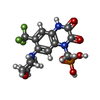
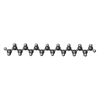
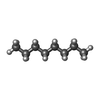
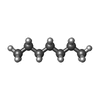
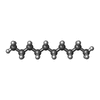
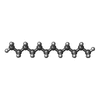
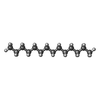
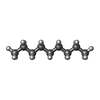









| #9: Chemical | ChemComp-ZK1 / {[  Fanapanel Fanapanel#10: Chemical |  Hexadecane Hexadecane#11: Chemical | ChemComp-OCT /  Octane Octane#12: Chemical | ChemComp-HP6 /  Heptane Heptane#13: Chemical | ChemComp-D10 /  Decane Decane#15: Chemical | ChemComp-D12 /  Dodecane Dodecane#16: Chemical | ChemComp-C14 /  Tetradecane Tetradecane#17: Chemical | ChemComp-DD9 /  Nonane Nonane#18: Chemical | |
|---|
-Details
| Has ligand of interest | Y |
|---|
-Experimental details
-Experiment
| Experiment | Method:  ELECTRON MICROSCOPY ELECTRON MICROSCOPY |
|---|---|
| EM experiment | Aggregation state: PARTICLE / 3D reconstruction method:  single particle reconstruction single particle reconstruction |
- Sample preparation
Sample preparation
| Component |
| ||||||||||||||||||||||||||||||
|---|---|---|---|---|---|---|---|---|---|---|---|---|---|---|---|---|---|---|---|---|---|---|---|---|---|---|---|---|---|---|---|
| Source (natural) |
| ||||||||||||||||||||||||||||||
| Source (recombinant) |
| ||||||||||||||||||||||||||||||
| Buffer solution | pH: 8 | ||||||||||||||||||||||||||||||
| Specimen | Embedding applied: NO / Shadowing applied: NO / Staining applied : NO / Vitrification applied : NO / Vitrification applied : YES : YES | ||||||||||||||||||||||||||||||
Vitrification | Cryogen name: ETHANE |
- Electron microscopy imaging
Electron microscopy imaging
| Experimental equipment |  Model: Titan Krios / Image courtesy: FEI Company |
|---|---|
| Microscopy | Model: FEI TITAN KRIOS |
| Electron gun | Electron source : :  FIELD EMISSION GUN / Accelerating voltage: 300 kV / Illumination mode: FLOOD BEAM FIELD EMISSION GUN / Accelerating voltage: 300 kV / Illumination mode: FLOOD BEAM |
| Electron lens | Mode: BRIGHT FIELD Bright-field microscopy Bright-field microscopy |
| Image recording | Electron dose: 50 e/Å2 / Film or detector model: GATAN K3 (6k x 4k) |
- Processing
Processing
| Software | Name: PHENIX / Version: 1.17_3644: / Classification: refinement | ||||||||||||||||||||||||
|---|---|---|---|---|---|---|---|---|---|---|---|---|---|---|---|---|---|---|---|---|---|---|---|---|---|
CTF correction | Type: PHASE FLIPPING AND AMPLITUDE CORRECTION | ||||||||||||||||||||||||
3D reconstruction | Resolution: 3.9 Å / Resolution method: FSC 0.143 CUT-OFF / Num. of particles: 157000 / Symmetry type: POINT | ||||||||||||||||||||||||
| Refine LS restraints |
|
 Movie
Movie Controller
Controller














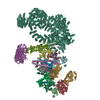
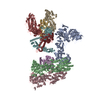

 PDBj
PDBj
















